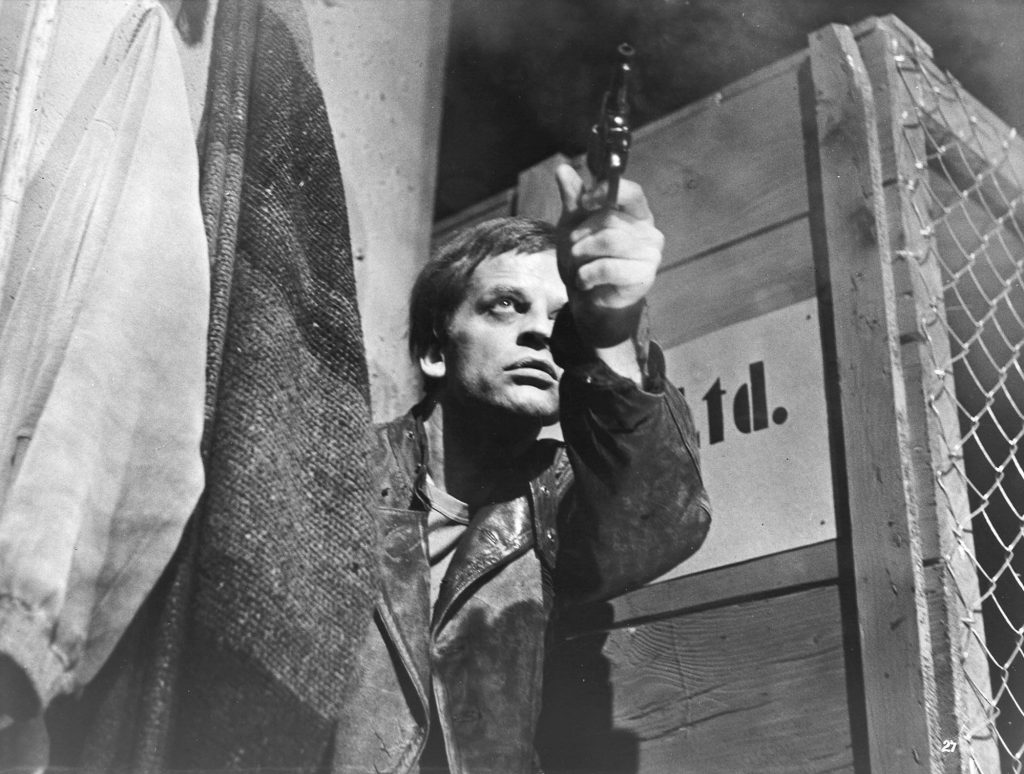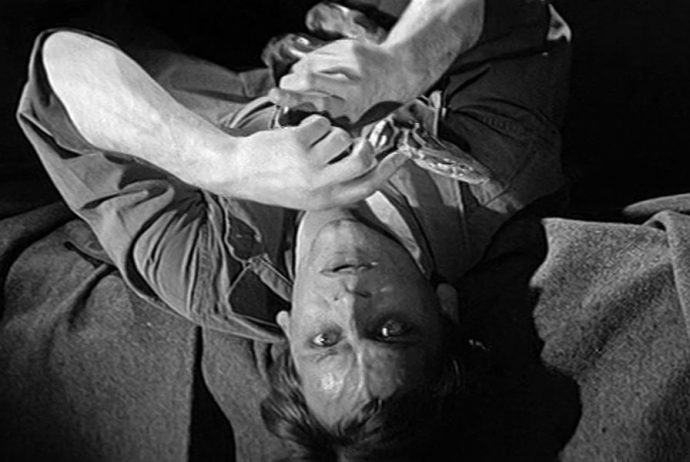Dir: Alfred Vohrer
Star: Heinz Drache, Barbara Rütting, Günter Pfitzmann, Klaus Kinski
a.k.a. The Squeaker
The alternate title seems to have lost a little in translation. Or, at least, a letter L, for “The Squealer” is more accurate. About the only squeaking to be heard here, is the brief exclamation given by a poor mouse that gets snatched up as dinner by a snake, the exotic reptile which helps power the plot. The squealer, on the other hand, is the mysterious character who rules the London underworld. If you have the misfortune to fall into his ill-graces – such as refusing the price offered for your loot – he has no qualms about betraying you to the police. Hence, the titular nickname.
While the cops seems fine with this, it appears that now something must be done. For as this film begins, the Squealer seems to have graduated from snitching to murder. People are turning up, apparently killed by the bite of a black mamba. This isn’t just not a native animal to England, it’s one which couldn’t even function in the depths of a British winter, making it an even more bizarre case. Investigating the case is Scotland Yard’s Inspector Elford (Drache), along with newspaper man Harras (regular krimi comic foil Eddi Arent), who keeps getting scooped by mysterious rival “Jos”.
Their inquiries bring them to Frankie Sutton (Pfitzmann), who runs an exotic animal supply business, with the help of the extremely creepy mute Krishna (Kinski). And by coincidence, he just “lost” a black mamba. They operate the firm on behalf of the former owner’s widow, Mrs. Mulford. Her husband committed suicide after falling victim to a blackmailer’s plot, leaving the business to her. Also in the mix of possible suspects are her niece, Beryl Stedman (Rutting), who is a wannabe crime writer, and a man recently released from jail, for Mrs. Mulford has a fondness for helping ex-cons. Which of them, if any, will turn out to be… the Squealer?

Based on Edgar Wallace’s 1927 novel of the same name, this was the fourth time one of his best-known works had been adapted into a movie. The first was just three years after the book was published, and was directed by Wallace himself, one of two such films. The following year, 1931, saw the first German adaptation, and there was another British version in 1937, this one produced by Alexander Korda. Remade once more as part of the sixties cycle of Wallace movies, it was the first of them to be made in scope, and also introduced the iconic opening sequence, with its “Hello. Hier spricht Edgar Wallace…” (“Hello. This is Edgar Wallace speaking…”).
It opens with a strong start, even before the credits. Krishna stalks through the English fog, before descending into the basement at Mulford’s, which is apparently used as their animal storehouse. He wanders past a couple of baby elephants and some llamas. But his mission is disturbed by another employee, who has to be dispatched ruthlessly by Krishna, and left dangling by a pit of alligators. [I am fairly sure this location would not pass muster by modern pet store standards] This lets him get what he came for: the case containing an African mamba, which Klaus snatches up and spirits off.
However, if you are expecting him to be a major player in the film, you will end up being disappointed, as that one sequence represents a good percentage of his screen-time. While’s he’s obviously involved in the murders, it’s more as a minion, carrying out the bidding of his unseen master on minor tasks. The important stuff, such as collecting the mamba venom, which is then frozen and used as lethal projectiles, is done by the Squealer himself. That said, Krishna does exude a creepy menace. It’s never clear if his silence is the result of some trauma or illness, or if he just doesn’t want to talk very much.

As shown, top, Krishna also has an apparent fondness for playing with his python. And, no, that’s not a euphemism, it’s a literal snake that he lets crawl over him. It’s an eerie foreshadow of what daughter Nastassja would do, a couple of decades later – at least Klaus keeps his clothes on. The snakes here are also a bit of an precursor to Kinski’s subsequent encounter with a black mamba, in 1981’s Venom. Though his character ended up as a victim of the poisonous reptile there, rather than weaponizing it. Maybe I need to start a really specialized website: KinskisWithSnakes.com.
There are a couple of really imaginative bits of cinematography by Karl Lob, to the point where they are arguably more a distraction than an enhancement. The one mentioned in just about every review is the shot from inside someone’s mouth, as they munch on a carrot! It’s probably just a bit much. But there is also another striking shot, looking up from the bottom of a sink, through the water, as the subject washes their hands. And, generally, the film looks very sharp, with excellent monochrome photography that frequently pops off the screen. The characters are quite fun too, a quirky bunch of potential criminal masterminds.
The problems are much more on the story-line side, with a plot which is confusing when it isn’t flat-out implausible. I mean, there are surely less convoluted ways to get rid of people than blowing frozen snake venom into them? And, let’s face it, such a method basically creates a large, flashing neon sign over any exotic animal supply houses, given that access to black mambas is not what you’d call universal, even in sixties London. It also doesn’t make MUCH sense for the Squealer to type up his blackmail notes on the same machine used for company business. All told, if this criminal mastermind was as smart as they are supposed to be, Inspector Elford would never have come within a mile of them.
But it does have Klaus cuddling a snake. And purely for that alone, it’s not without merit.
